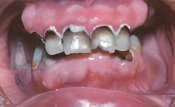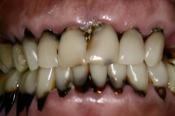Tooth Enamel Damage Treatment in Milwaukee Wisconsin
Understanding Enamel Loss: Disease Acids Physical
Healthy tooth structures are made up of a layer of enamel that completely envelops the tooth. This protective material ranges up from approximately 2.5 – 3.0 millimeters thick, typically on the biting surfaces. It is the hardest and most mineralized tissue in our bodies.
Perhaps the most common cause of enamel loss is due to the routine decay that most people experience as a simple cavity. Left untreated, as we all know, cavities become larger and larger and can completely destroy a tooth.
As patients, we all try to seek treatment to arrest and treat this condition as soon as we can. Prescription fluoride, fluoride treatments for adults and children can help as can diet modification.
The uncommon causes of lost, compromised or damaged enamel are numerous. Friction, trauma, birth or genetic defects, developmental growth patterns and many other causes are discussed here.
Understanding the types of causes and associating them with certain symptoms can help patients determine what they can do to conserve, maintain or possibly treat the loss of this important tissue.
Oral Health Habits
Sucking lemons, keeping candies and mints in mouths for hours or during sleep, sipping sugary drinks all day, chewing tobacco all day, snuff, smoking, dissolving medicines in mouth instead of swallowing. Sugary gum or sour gummi bears that have citric acid that dissolves teeth.

Oral Disease
Fevers at young age, antibiotics while teeth developing in utero, periodontitis leading to food impaction in crevices around teeth. Xerostomia – dry mouth due to medication or illness or age. Oral disease mirrors systemic disease. Leukemia, HIV, Diabetes, cancers, all can influence caries/cavities due to immunocompromised systems.
Trauma
Fracture, chips, missing tooth or fillings can lead to impaction of bacteria, decay and further breakdown.

Bulimia Purging
Acid attack, gasses from stomach, acid reflux, vomit acids.

Eating Preferences – Habits
Excess candy consumption, lack of proper nutrition, high fructose corn syrup. – Chewing Tobacco

Friction
Fillings that are too high, poorly shaped, pitted, old ditched, can pack food leading to deterioration and decay.
Occlusal
Grinding, Bruxism (nocturnal grinding), posturing things between teeth, using teeth as tools.
Incompatibility with Previous Dentistry
Leaking crowns that don’t fit, cement that has leached out leaving gaps for bacteria to seep through, overhangs (rough fillings or excess fillings that tear floss and pack food) that trap bacteria.

Genetic Birth Defects
Ectodermal dysplasia
Developmental Growth Abnormalities
Amelogenesis or Dentinogenesis imperfecta are factors that can lead to pitting and decay.
Prevention Control Treatment of Enamel Damage
Loss or deterioration of enamel can have many causes, as outlined above. Whether or not there is a fix, cure (a misnomer, really), or method for repairing affected enamel is based on the original cause.
In many situations the treatments of choice that offer strong predictability of success, both functionally and cosmetically, are the use of restorative procedures recommended by a cosmetic dentist. New porcelain crowns for restoring deteriorating teeth to natural contours and function, buildups and fillings to test a new bite or restore lost biting relationships, implant crowns, bridges and quality feldspathic porcelain offer a variety of creative methods for overcoming the loss of enamel.
In cases where enamel loss is arrested early (perhaps due to poor dietary habits) certain types of mineralizing agents in the form of toothpastes and rinses can be successful.
Below is a very brief outline of anticipated treatments for each of the categories of enamel loss.
Some are homeopathic, and can be done at home. Others require the expert help of an experienced dentist.
Oral Health Habits
Consciously changing behavior, biofeedback, splint therapy or appliances to change habits such as NTI or the Best Bite Discluder.
Oral Disease
Cariology (study of cavities) bears out that it is a disease. Complete eradication is needed to stop the spread of the bacterial infection that is caries. Fluoride releasing fillings, mouth-rinses, and systemic medication can all be useful adjuncts to stopping carious lesions from spreading.Fluoride releasing fillings, crowns with fluoride cements, trays for at home fluoride treatments and behavior modification are all possible treatments.
Eating Preferences – Habits
High fructose corn syrup found in sodas, juice drinks, sports drinks as well as energy bars are bathing teeth in sugar. Blended coffee drinks and the decrease in milk consumption have been blamed in the increase in rampant tooth decay. Solution, see oral disease.
Bulimia Purging
Behavioral Psychologist, medication, and restoration with crowns and orthodontics when stable.
Trauma
Root canal therapy if needed, large restorative fillings to restore teeth to high strength, and crowns or protective caps.
Friction
Mouthguards, occlusal adjustments, equilibration or evening out of bite. Rehabilitation or reconstruction of bite.
Occlusal
Mouthguards, splints, adjustment of bite. Possible rehabilitation of bite with crowns or posterior porcelain or gold restoration.
Incompatibility with Previous Dentistry
Replace it with modern state-of-the-art- restorative dentistry to include gold, porcelain,zirconium, pressed or feldspathic porcelain.
Genetic Birth Defects
Restoration of missing teeth or pitted teeth with fillings or crowns. Missing teeth to be replaced with implant supported crowns or bridges.
Developmental Growth Abnormalities
See genetic birth defects.
Call 414-464-9021 for information on any of our services.
Check out our Dental Blog >>
Read our Patient Case Studies >>
Hampton Dental Associates is proud to offer affordable dentistry programs to help you regain your perfect smile.
Learn more about our affordable dentistry options.


